[Alley Valkyrie is one of our talented monthly columnists. If you like her stories and want to support her work at The Wild Hunt, please consider donating to our fall fundraising campaign and sharing our IndieGoGo link. It is your wonderful and dedicated support that makes it possible for Alley to be part of our writing team. Thank you very much.]
I came across the marsh last spring on my very first walk through the new neighborhood.
Three blocks from my building I stumbled upon it, flourishing within the confines of a city block in sharp contrast to its immediate surroundings. Overshadowed by condominium complexes on three sides, a vacant lot sits to the north, and then another park on the other side of that lot which stretches to the riverfront. The vacant lot allows for a breathtaking view of the Fremont Bridge gracefully arcing over the Willamette River.
Tanner Springs Park, as the marsh is officially known, is a modern recapture/recreation of the creek and wetlands that flowed through this area up until the late 1800’s. The original creek was filled in to make way for industrial development, which dominated this area from the turn of the century until approximately twenty-five years ago. When the industrial cover was eventually stripped away in order to plan the neighborhood as it stands today, the city was presented with an opportunity to restore a small piece of the natural topography, which eventually manifested as a thriving, swampy ecosystem contained within the boundaries of a city block. The park is not only specifically designed to capture storm water as the native environment once did; the storm water is then treated and pumped back into the spring as opposed to simply being directed back into the river.
Since that first encounter with the marsh, I’ve visited the spot nearly every day, sometimes only for a minute or two and other times for the better part of an afternoon. The marsh feels very tucked into itself; there is something very grounding and psychically cohesive about the block that is not felt among its surroundings. There are strange spirits among the grasses and ponds here, spirits both old and very, very new, and their presence seems to magnify the more I pay attention to them. The marsh is both beautifully out of place and also completely fitting as it stands. Its surroundings protect and isolate it while highlighting it at the same time, and the open space between the block and the river creates a positive aesthetic flow that opens up the surrounding neighborhood in a very distinctive and pleasing manner.
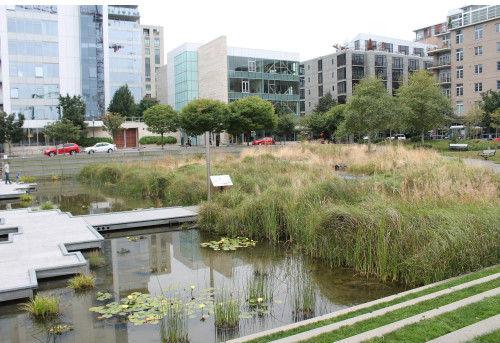
The wonderful marshiness of Tanner Springs Park
At the marsh, I can hide in plain sight. The more I pay attention to the everyday details, which are contained within its borders, the more the everyday details outside of its borders become more obvious to me. I have developed an energetic reciprocity with this spot, and the spirits have made it clear that they welcome my presence. In a sense, it’s the only block in this neighborhood where I feel at ease.
* * *
For the past seven years, I had been deeply engaged in a close relationship with a small section of the Willamette River, specifically the curve that defines the border of Alton Baker Park in Eugene; a spot that the State of Oregon defines as River Mile 183, and that I could never quite define myself.
Nowadays, I live exactly 172 river miles north of that spot in a building that sits a few hundred yards away from the west bank of the Willamette in Portland at River Mile 11. While the mile markers of the Willamette generally don’t carry a specific connotation, River Mile 11 is significant and often referred to by name due to the fact that it marks the furthest point upstream where the Willamette has been designated as a Superfund site. From the Broadway Bridge downstream several miles to Sauvie Island, the river suffers from highly elevated levels of toxicity due to well over a hundred years’ worth of industrial activity on the waterfront. The banks and waters of River Mile 11 are specifically noted for their toxicity apart from the rest of the Superfund site. The area from the Broadway Bridge downstream to the Fremont Bridge is the only stretch of the Willamette in Portland where swimming is not only ill-advised but advisory groups caution against even walking barefoot on the riverbank.
The toxic effects of a century’s worth of industry was not confined to just the water itself. The housing complex I live in was built on top of formerly toxic brownfields, as were many of the surrounding buildings and current features of the neighborhood including my beloved marsh. But while the toxicity on the land has been cleaned up to an extent over the past twenty years, any substantive cleaning of the river itself has yet to begin.
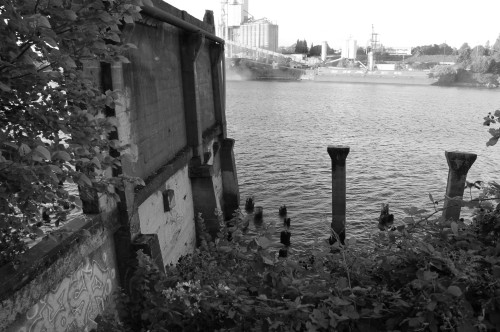
The view at River Mile 11
I have learned that she is both the same river I knew in Eugene and a completely different character at the same time. I feel as if I’ve gotten to simultaneously know her in two separate stages of her journey. The youthful exuberance of the Willamette at Mile 183 is largely absent from the river that now sits across the street from my building. Here, the river has been altered into submission, industrialized to a point where the energies that I easily sensed in Eugene are almost unrecognizable. And yet, she is my old friend all the same. And, while I miss dipping my feet in, the understandings and lessons that I am quickly gaining from living on this stretch of the river far outweigh what I used to take for granted.
* * *
I stood in front of the statue, keeping in mind that the imposing woman before me was the second-largest copper repouseé statue in the country after Lady Liberty herself. Hunched down, she reaches out to me with her right hand as she wields a trident in her left. I take in her essence, both fierce and inviting. In the tradition of Columbia and Brittania as well as Lady Liberty, she is intended to embody the persona of this city. I feel that she does in many ways, although not necessarily in the ways that were originally intended. For me, she is a powerful symbol of what is held back as much as what she inspires to push forward.
Symbols hold tremendous power, and one of the reasons that the Statue of Liberty is such a powerful symbol is that she can be seen everywhere. One does not have to visit her in person to quickly conjure up her likeness in the imagination. She appears on everything from birthday cakes to snow globes, and to step inside of any New York City tourist shop is to be visually assaulted with countless versions of her likeness.
The statue I stood before at that moment, however, is barely a recognizable symbol at all. Her likeness is restrained under threat of litigation. Despite the fact that the statue was built with public funds, the statue’s creator retains the copyright to the statue’s image, in contrast to most publicly funded art, which is generally in the public domain. Not only does the artist retain the copyright, he aggressively enforces it, which means that commercial reproductions of the statue’s image are practically non-existent. You will not find a cheap postcard with her image in a tourist shop.
Interestingly enough, despite its failure to become a symbol of any sort, the statue’s name is instantly recognizable among the American public, albeit the association is far removed from its original source. When people hear the name “Portlandia,” they generally think of a television show, not the beautiful copper goddess that kneels before me at that moment.
Standing before her, it struck me as strangely fitting, in a depressing sense, how the name of this statue has come to be primarily associated with a show that satirizes the very real tendencies and excesses of hipster capitalism, as opposed to being associated with the statue itself, a powerful and potentially iconic image that has been intentionally repressed and held back from mainstream recognition on account of its creator’s excessive love affair with capitalism.
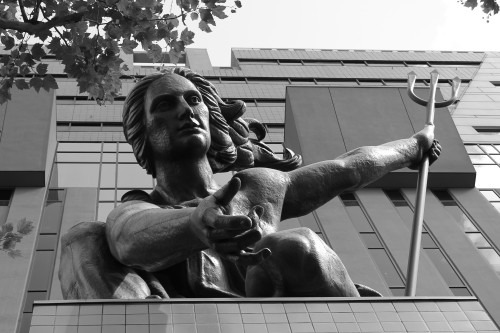
Portlandia
I left a flower for Portlandia at the entrance to the building that she hovers over, and bid her adieu. As I walked away, I deliberately tried to picture her in my mind as I had just seen her, but strangely enough, or perhaps not strangely at all, her specifics had already become a bit of a blur.
* * *
The cargo trains are often close to a mile long, and several times a day they slowly roll past less than a hundred feet from my bedroom window. When the cargo is mainly lumber, my throat occasionally tightens as I think of the forest, but my throat tightens much more when I spot the ominous black tanker cars that I know to be carrying crude oil, mostly from the Bakken region of North Dakota en route to a refinery near Clatskanie, Oregon.
The oil trains have been a subject of controversy, especially since a tragic accident in Quebec last year when a train carrying Bakken crude derailed, killing 47 people. Oil trains started running through Portland a few years ago without public notice or input, and oil train shipments have increased 250% just in the past year. Railroad companies are not required to report the entirety of their oil shipments through Oregon; only trains that are carrying over a million gallons of Bakken crude on a single train, the equivalent of approximately 35 cars, must report.
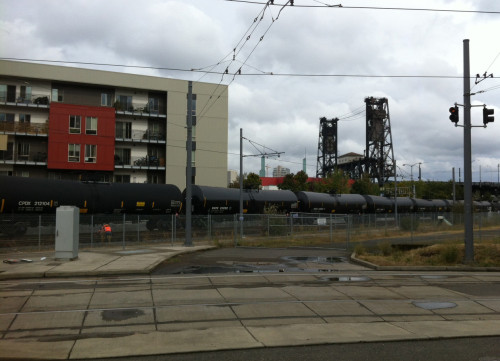
Oil train crawling past my building complex
Aside from the dangers of transporting crude oil in the first place, the frequency and slowness of these cargo trains creates additional environmental and quality-of-life issues on a local level. Vehicles are stopped several times a day for the trains to pass, and dozens of cars sit idling, sometimes for the better part of an hour, while stopped in a narrow traffic corridor lined on both sides by residential apartment buildings. Especially in the summer, and when the air is already stagnant, the build-up of car fumes as the train crawls past is noticeable and unpleasant.
There’s a cruel irony in witnessing all the refined oil being wasted as cars just sit there in frustration. These cars, which are often covered in pro-environment bumper stickers, idle away, waiting for the trains carrying Bakken crude to pass on the final stage of the journey towards becoming refined oil.
* * *
A block south from the marsh, I walked down Lovejoy Street and once again couldn’t ignore how new the corridor felt. The entire neighborhood feels new to an extent, which makes sense in that most of the development is less than thirty years old. But Lovejoy Street radiates newness in a way which truly captures the feel of the neighborhood.
In relation to the surrounding neighborhoods, I can’t help but to liken the Pearl District to an ultramodern bathroom in an otherwise old Victorian house. From the turn of the last century until the late 1980s, this area was simply known as the NW Industrial area. Then rezoning and the removal of the viaduct that towered over Lovejoy Street opened up the area for development. The classic gentrification pattern followed: artists moved in, developers followed, artists were then priced out, and today the Pearl District is one of the most affluent neighborhoods in Portland. It’s a neighborhood that reminds me more of SoHo in New York City than anyplace else.
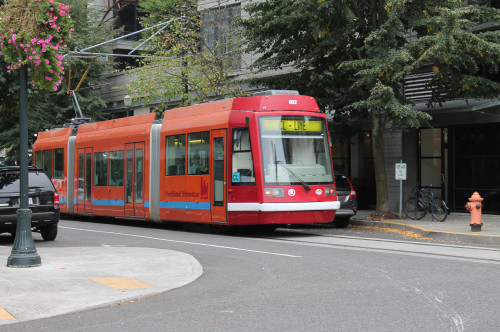
The Portland Streetcar one block north from Lovejoy Street
I did not choose this neighborhood — this neighborhood chose me. My ideal vision of living in Portland consisted of a cute little bungalow in the southeast with a garden in the backyard, but the Gods had other plans. I surrendered once I realized what was at work and, while there is something awkward and distressing about both the newness and the lack of standing history in the area, the why part of the “why here?” question is starting to become clearer to me by the day. Right now, within that one question, my task is to simply bear witness and take notes.
* * *
I was sitting at the edge of the dock at the marsh last month when I first heard the sound of the pile driver. I looked over at the vacant lot in horror, and noticed that overnight the lot had been surrounded with fencing and filled with construction equipment. I realized immediately that my beloved view of the Fremont Bridge was about to disappear.
And though I’ve only lived here since last Spring, it feels very personal and very raw in its effect upon me.
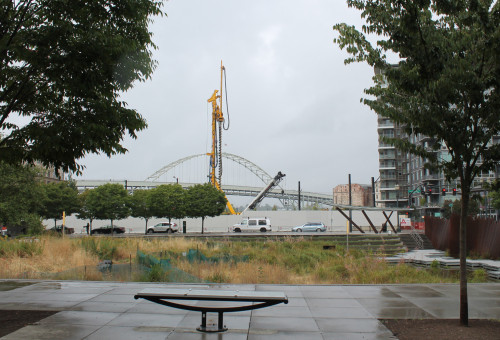
The view, interrupted by a wall and a pile driver
Every day since, I’ve watched as the hole in the ground expands, and the pile driver has just recently been replaced by a crane as concrete paneling is quickly ushered in. Most who walk by seem much more affected and upset by the sound of the construction itself than the fact that another huge mega-building is about to go up in the vacant lot, destroying the open feel of the park. Part of me, the small part that tends to envy the bliss inherent in ignorance, wishes I was as unaffected as everyone else who walks past. But I just can’t shake the inevitability and the reality of the impending loss.
Slowly but surely, developers are stealing a little piece of my sky.
The spirits in the marsh seem unsettled and anxious; their feelings mirroring my own, affected by not only the construction but by the utter disenchantment in everyone around us. Sitting in the marsh, it feels like the spirits and I are the only ones who feel that there’s something subtly disturbing in the acceptance and normalization of urban development as it occurs before us. For everyone else, it seems to be business as usual.
This neighborhood has many impressive features: three well-designed parks, several coffee shops, countless yoga studios and art galleries, Portland’s first dog gym, a spiffy new streetcar line, and more “sustainable” restaurants than one could possibly track. But what it notably lacks is what stood out for me the most at that moment. It lacks both a collective memory as well as a cohesive community spirit.

* * *
I came back from lunch to learn that activists from Portland Rising Tide had temporarily blockaded the train tracks leading to Clatskanie as a protest against the shipment of crude oil.
I sat with this for a moment, silently honoring anyone and everyone who potentially puts themselves in harm’s way in the name of environmental justice. At that moment, I heard the train signals clanging outside my window, and I could tell from the sound against the tracks that it was a cargo train.
Quickly, I ran out of my building to see the black oil tanks snaking their way down the tracks towards the Steel Bridge. At the end of the side street, I saw vehicles backed up over a mile in each direction from the tracks, most of them idling away as the oil train crawled past. I looked behind me, and something on the light-post caught my eye. It was a faded sticker that read “Portland: America’s Greenest City.”
I glanced out across at the river and, as the sun reflected off the water, I remembered hearing that there was currently a rare and toxic algae blooming on the Willamette. The advisory not to enter the water now reached far past the confines of River Mile 11. The oil train made its way across the Steel Bridge as I looked on; an ugly feeling grew in the pit of my stomach as I watched the dangerously toxic train cross the dangerously toxic waters.
I walked back in the other direction and headed over the pedestrian bridge that crosses the tracks at Union Station. On the bridge, I looked out at the train. Its black cars stretched eastward as far as the eye could see. A few tourists walked by, snapping pictures from the overpass, and then stopped to stare at a map for a few moments. I asked them what they were looking for.
“Do you know where we can find that big statue, the one that you see in the intro to ‘Portlandia’?” they asked me.
I pointed to a spot on the map. “Just so you know, Portlandia is actually the name of the statue itself,” I told them. “That’s where the show got its name from.”
They looked at each other, surprised. I smiled and nodded and continued walking across the bridge. At the bottom of the stairs, I paused for a moment. My original destination had been the marsh, but I suddenly felt the urge to bring a flower to Portlandia once again.
I took off in the direction of the statue, tuning out the sound of the oil train in the background as I conjured up the image of Portlandia in my mind’s eye and, for the first time, I was truly able to picture her clearly.
The Wild Hunt is not responsible for links to external content.
To join a conversation on this post:
Visit our The Wild Hunt subreddit! Point your favorite browser to https://www.reddit.com/r/The_Wild_Hunt_News/, then click “JOIN”. Make sure to click the bell, too, to be notified of new articles posted to our subreddit.
Another beautiful piece, and now my heart aches for Portland, the first city I ever fell in love with and my first home in the U.S. It was in Portland that I began waking up and seeing the world around me, the ugliness and the beauty, and the conflict and interplay between both. Portland will always hold a special place in my heart, and she is richer for having such an amazing writer in her. Thank you for sharing your experience with us and next time you see Portlandia, bring an extra flower for me.
I will. Thank you. 🙂